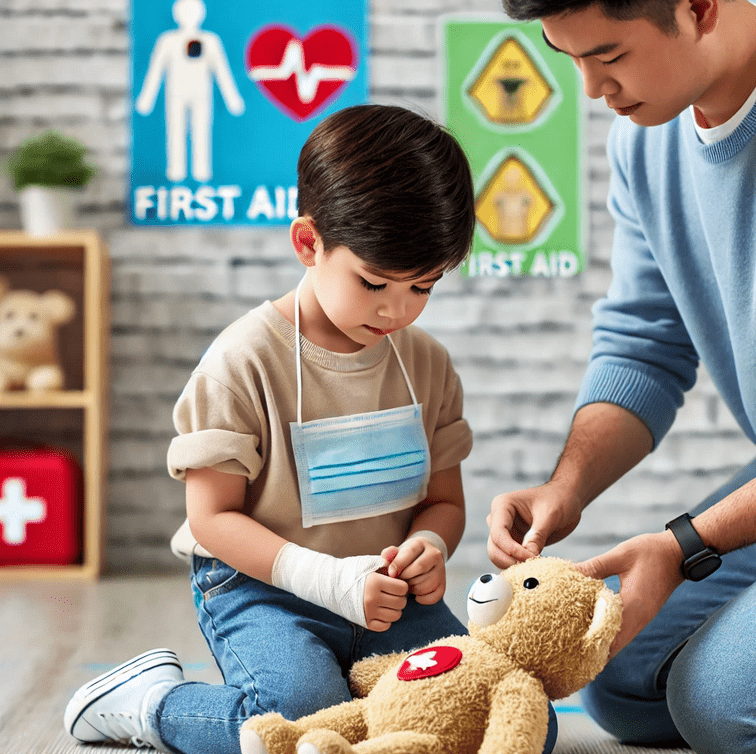Teaching kids first aid is not only empowering but also helps them develop confidence and responsibility in dealing with minor injuries and emergencies. Knowing basic first aid skills can make a significant difference when accidents happen.
This article outlines essential first aid skills that every child should learn and provides practical tips on how to teach them effectively.

1. How to Treat Minor Cuts and Scrapes
Children are prone to cuts and scrapes during playtime, so it’s crucial they know how to clean and dress a minor wound. The following steps can be taught:
| Step | Action |
|---|---|
| 1 | Wash your hands to avoid infection. |
| 2 | Clean the wound gently with water and mild soap. |
| 3 | Pat the wound dry with a clean cloth or tissue. |
| 4 | Apply an antiseptic cream to prevent infection. |
| 5 | Cover the wound with a bandage or adhesive strip. |
Tip: Use a doll or stuffed animal to demonstrate the process before allowing kids to practice on themselves or a parent (with supervision).
2. How to Stop a Nosebleed
Nosebleeds can be scary for children, but teaching them how to handle it calmly will help reduce their anxiety. Follow these steps:
| Step | Action |
|---|---|
| 1 | Sit up straight and lean forward slightly (to avoid swallowing blood). |
| 2 | Pinch the soft part of the nose (just above the nostrils) with thumb and index finger. |
| 3 | Hold for 10 minutes while breathing through the mouth. |
| 4 | Once the bleeding stops, avoid blowing the nose for a few hours. |
Nosebleed Chart: Duration and Actions
This chart helps visualize the steps and times involved in managing a nosebleed.
| Time (Minutes) | Action |
|---|---|
| 0 – 10 | Pinch the nose firmly. |
| 10 – 15 | Release the pinch slowly. |
| 15+ | If the bleeding continues, seek medical help. |
3. How to Handle Burns
Burns are common among children, especially in the kitchen or near hot surfaces. Here’s how they can treat minor burns:
| Step | Action |
|---|---|
| 1 | Cool the burn under running water for 10-20 minutes. |
| 2 | Cover the burn with a clean, non-stick bandage or cloth. |
| 3 | Avoid using ice, butter, or oily substances, as they can worsen the injury. |
| 4 | Seek medical help if the burn is large or causes blisters. |
Burn Severity Chart
This chart helps children understand the difference between minor and severe burns.
| Type of Burn | Symptoms | Action |
|---|---|---|
| Minor (First-Degree) | Red, dry skin, minor swelling | Cool with water, bandage, observe. |
| Severe (Second/Third-Degree) | Blisters, white or charred skin, intense pain | Seek medical help immediately. |
4. Choking: How to Perform the Heimlich Maneuver
Choking is a serious situation, and children should be familiar with the Heimlich maneuver (also known as abdominal thrusts). However, younger children should always seek adult help before attempting this. Here’s a simple explanation:
| Step | Action |
|---|---|
| 1 | Stand behind the choking person and wrap your arms around their waist. |
| 2 | Make a fist and place it just above the navel. |
| 3 | Grab your fist with your other hand and press hard into the abdomen with quick, upward thrusts. |
| 4 | Repeat until the object is dislodged or the person can breathe again. |
Choking Rescue Flowchart
This flowchart visually represents the steps in rescuing a choking person.

5. CPR: A Lifesaving Skill
While CPR (Cardiopulmonary Resuscitation) is more advanced, older children can start learning the basics. Here are the steps:
| Step | Action |
|---|---|
| 1 | Ensure the area is safe, and check for responsiveness. |
| 2 | Call 911 or alert an adult. |
| 3 | Place your hands in the center of the chest and push hard and fast (about 100-120 compressions per minute). |
| 4 | Continue until help arrives or the person starts breathing again. |
CPR Compressions Rate Chart
This chart shows the recommended compression rates during CPR.
| Age Group | Compression Rate (Per Minute) |
|---|---|
| Children/Adults | 100 – 120 compressions |
| Infants (under 1) | 120 compressions |
6. When to Call for Help
It’s important that children know when and how to seek help in an emergency. Teaching them to dial emergency numbers like 911 is critical. Encourage them to:
- Stay calm and speak clearly.
- Know their full name, address, and a description of the emergency.
- Stay on the line until help arrives.
Emergency Contact Table
Create a list of contacts and keep it in an accessible place:
| Name | Relationship | Phone Number |
|---|---|---|
| Mom | Parent | 555-123-4567 |
| Dad | Parent | 555-987-6543 |
| Neighbor | Trusted Adult | 555-456-7890 |
| 911 | Emergency | Call in emergencies |
Conclusion
First aid training for kids helps build confidence and equips them with practical skills that could save a life or prevent a minor injury from becoming serious. Whether it’s treating a small scrape, managing a nosebleed, or recognizing when to call for help, these skills are essential. The more comfortable children are with basic first aid, the better they’ll be at staying calm in emergencies. Through engaging activities, step-by-step guidance, and easy-to-understand resources like charts and tables, children can quickly learn how to handle common first aid situations with ease.
Incorporating fun learning methods like role-playing and using visual aids like the charts above can make the process more enjoyable and memorable for children.

No comments yet